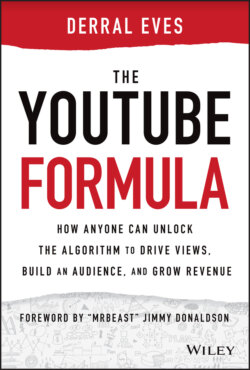Читать книгу The YouTube Formula - Derral Eves - Страница 17
2 The YouTube Ecosystem
ОглавлениеIn order for us to understand how YouTube really works, first we need to look at how it operates as a digital ecosystem. A digital ecosystem works much like a natural ecosystem: there are a lot of moving parts, and all of those parts affect the organization as a whole. Grade‐school science taught us about energy flow in a natural ecosystem; photosynthesis, plants and animals, decomposition, and nutrient conversion are all part of the cycle. Every factor in the chain has its job to do, and if it doesn't work right, it affects the entire operation.
YouTube's ecosystem also has a flow and cycle, and its contributors affect the whole, for better or for worse. This digital ecosystem includes the creator, the viewer, the advertiser/brand, copyright holders, multichannel networks (MCNs), and YouTube itself.
Here's a quick summary of how the YouTube ecosystem works: creators make videos and upload them to YouTube. Brands pay YouTube to run advertising alongside uploaded content, either before or during a video. When a channel meets the ad sharing program requirements, it gets a cut of the money from the ads running on their content. Brands also connect with creators who they think will be able to increase brand awareness and/or their bottom line. This influencer marketing is a huge part of YouTube's ecosystem. The viewers come to interact with content, creators, and communities. They watch, subscribe, comment, like and dislike, save, and share. YouTube as a website is the host of the ecosystem, but as a company, it's a part of the ecosystem. YouTube the company has to make sure everyone in the ecosystem is satisfied. They field complaints and legalities. They ultimately make the rules, but the rules evolve over time based on feedback from the ecosystem and what needs to be addressed. MCNs played an important role in the beginning of YouTube, connecting brands with creators and managing other elements of the creator experience. They also helped try to problem‐solve because YouTube didn't have the creator support at the time. Creators don't have to work with MCNs; they can manage their own channels and deal directly with brands or work with agencies to connect with brands. Finally, copyright holders want their original work attributed to them without being stolen or copied. They want to keep any financial benefit from that content coming back to their original content.
To be a part of this digital ecosystem, understand the role each contributor plays, especially the role you intend to occupy. For example, if you are a creator, become familiar with YouTube's guidelines so your content can get monetized and stay monetized. Don't steal or copy someone else's content, but if you intend to use clips of scenes or songs or any other copyrighted material, know how to go about it legally. Your content's success depends on your understanding your role in the ecosystem. Your YouTube experience should be more than starting a channel and uploading videos. In fact, if this is your methodology, your video will never reach viewers. YouTube rewards original content that's made for a specific audience, so if you learn the system and follow the rules, your videos have a greater chance of being seen.
